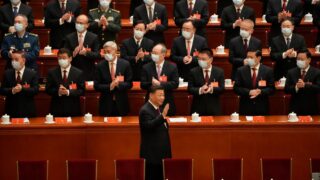These are the first punishments levied against officials in China and Hong Kong for repressing pro-democracy protests in the region.
WASHINGTON — The Trump administration on Friday imposed sanctions on 11 senior Chinese Communist Party officials and their Hong Kong allies, including chief executive Carrie Lam, over their role in cracking down on political dissent in the southern Chinese territory.
These are the first sanctions against officials from China and Hong Kong over suppression of pro-democracy protests and dissent in the territory. They are being imposed as actions following an executive order President Trump signed last month seeking to punish China for its repression in Hong Kong.
“The United States stands with the people of Hong Kong and we will use our tools and authorities to target those undermining their autonomy,” Steven T. Mnuchin, the Treasury secretary, said in a statement.
The action is another in a series of measures the Trump administration has taken in recent months to ratchet up pressure on Beijing. Last month, the administration imposed sanctions on the Chinese government, including a senior member of the Communist Party, over human rights abuses against the largely Muslim Uighur minority.
Beijing announced in June that it was imposing a new national security law in Hong Kong to grant security agencies expansive powers to crack down on dissent.
Since then, American officials have debated how to get Beijing to roll back the law or how to penalize the action.
Last month, Mr. Trump signed an executive order ending the special status that the United States grants Hong Kong in diplomatic and trade relations, saying Hong Kong was no longer an autonomous entity, and officials are now beginning to treat the territory like mainland China.
Some administration officials had wanted Mr. Trump to announce during the signing that his government was imposing sanctions on Ms. Lam and other officials in China and Hong Kong. The president declined to do so then.
The current flurry of actions against China dovetails with a core part of Mr. Trump’s campaign strategy. His campaign aides are trying to show Mr. Trump is hitting China hard in order to shift the national conversation from his failures on managing the coronavirus pandemic and the economy.
The initial virus outbreak began in central China, and Mr. Trump has blamed Chinese officials for failing to contain it, though he also praised China’s leader, Xi Jinping, for efforts this winter.
Some of the administration’s China hawks are trying to set the two nations on a course for long-term confrontation and ensure that relations remain in a state of open rivalry even if Democratic candidate Joseph R. Biden Jr. wins the November election.
FEATURED IMAGE: A July pro-democracy protest in Hong Kong.Credit…Lam Yik Fei for The New York Times
By Pranshu Verma and Edward Wong/ The New York Times





